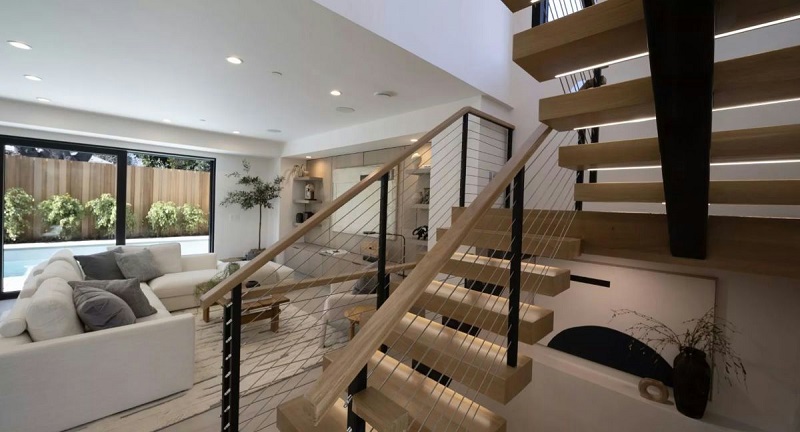Situated in the desirable Studio City neighborhood in Los Angeles, Saint Clair is a home perfectly suited to handle anything that the City of Angels can throw its way — all while enhancing and protecting the peace of its occupants, thanks to its sustainable and luxurious passive design.
Having worked together since 2008, husband and wife duo Kyle and Mary Kovacs of Aramyan Kovacs Design completed the first-ever Phius-certified home in L.A., inspired greatly by their roles as parents. The project, which wrapped up in 2023, initially began coming to life after a conversation between Kyle and Mary about the legacy they were leaving for their three children.
"He's like: 'I want to leave something behind for the kids. Show them what is important in this world. It's not just what we want, what we need, and [these] beautiful things we build for our clients,'" Mary, the architect and interior designer of Saint Clair, shared with The Cool Down on a video call with engineer and builder Kyle and Phius co-director and technical lead Lisa White.
She added: "... And I think that's where the conversation started between us about sustainability — and building smarter, building wiser, building cleaner."
The climate-specific nature of Phius design is one of the factors that made the couple confident that building to Phius standards was the right move. While the planet-friendly elements were undoubtedly a huge part of their inspiration, so were the multidimensional benefits.
"The house has a constant temperature," Kyle shared with The Cool Down, detailing how energy-modeling software assisted with the Phius-certified design for L.A.'s hot weather.
Save $10,000 on solar panels without even sharing your phone number Want to go solar but not sure who to trust? EnergySage has your back with free and transparent quotes from fully vetted providers that can help you save as much as $10k on installation. To get started, just answer a few questions about your home — no phone number required. Within a day or two, EnergySage will email you the best local options for your needs, and their expert advisers can help you compare quotes and pick a winner. |
"Yes, it's for the Earth, but it's also for you," Mary said, explaining that the construction makes a difference in the quality of life starting on day one.
For one, the long-lasting, beautifully aging golden balau wood in the entry and throughout Saint Clair creates a welcoming and soothing ambiance that Mary said multiple guests have described as experiencing a "warm hug," with ample natural light and desert oak cabinetry also helping to foster a sense of connection to the outdoors.
Meanwhile, European door and window systems create an airtight seal when closed, resulting in a comfortable and quiet sanctuary from the bustling noise of L.A.
These features also help equip Saint Clair to handle smog and smoke from extreme weather events like wildfires — which have become more intense and frequent as the planet has warmed primarily due to dirty fuel usage.
TCD Picks » Upway Spotlight
💡Upway makes it easy to find discounts of up to 60% on premium e-bike brands

Another part of the equation is an HRV (air filtration) system that runs 24/7 from clean energy generated from rooftop solar panels, which provide more than enough non-polluting power for the entire space.
According to the American Lung Association, L.A. County has a failing grade in annual ozone and particle pollution, meaning that its weighted grade system found air quality had reached unhealthy levels more often than not.
Considering that the World Health Organization has linked more than three million annual premature deaths to household air pollution, building to the exceptional and rigorous Phius airtightness standards was a no-brainer. As a bonus, it contributes to the house's ability to smell fresh even after long periods away and practically eliminates the need for any dusting.
However, the airtightness doesn't mean the home feels claustrophobic. Two 16-18 feet glass doors open wide to a backyard entertaining area with a barbecue, fireplace, pool, and jacuzzi, making the house seem as though it doubles in size. A 10-foot pass-through window limits the need for back and forth when transferring food.
"On a good day, go ahead and open those doors and windows and let everything flow," Mary told The Cool Down. "... Some people say: 'Oh, it's a passive house, it's airtight. Does that mean I can't open my doors or windows?' No. Just, you have the peace of mind that when you close it, your air is being completely purified again."
"[There's] this feeling that sustainability might be, like, you have to sacrifice. And this project is a very obvious example that you don't. It actually provides more," White added, speaking further to debunk the common misconception that people in colder climates (including on the East Coast) are the only ones who benefit from passive design.
"It's not just about saving heating energy," White explained. "... It's about all of these quality elements that Mary and Kyle have been talking about."
"What we love about passive house is it's not a gimmick. It is real," Mary added. "... You're doing good for yourself. You're doing good for the environment. You're saving money, whether it's charging your car, heating your pool, you don't have any of those expenses anymore."
Kyle also suggested that the intangible qualities are just as valuable, even though many benefits of Phius construction can be quantified, tracked, and measured.
"It's hard to quantify [the quality of the indoor environment]," Kyle shared with The Cool Down when asked what he wished people knew. "You have to feel it."
Join our free newsletter for weekly updates on the latest innovations improving our lives and shaping our future, and don't miss this cool list of easy ways to help yourself while helping the planet.















